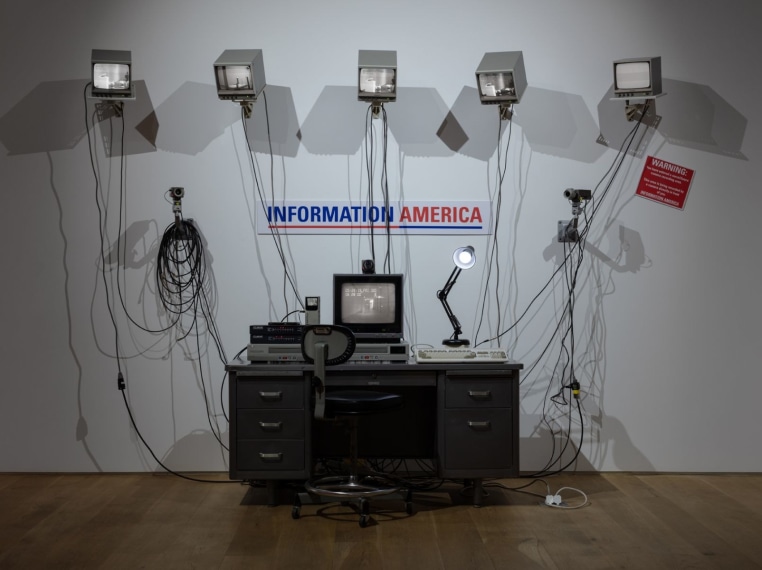
Installation View, Ortuzar Projects, EXPO CHICAGO 2023. Photo: Evan Jenkins.
Installation View, Ortuzar Projects, EXPO CHICAGO 2023. Photo: Evan Jenkins.
Installation View, Ortuzar Projects, EXPO CHICAGO 2023. Photo: Evan Jenkins.
Installation View, Ortuzar Projects, EXPO CHICAGO 2023. Photo: Evan Jenkins.
Installation View, Ortuzar Projects, EXPO CHICAGO 2023. Photo: Evan Jenkins.
Installation View, Ortuzar Projects, EXPO CHICAGO 2023. Photo: Evan Jenkins.
Installation View, Ortuzar Projects, EXPO CHICAGO 2023. Photo: Evan Jenkins.
Installation View, Ortuzar Projects, EXPO CHICAGO 2023. Photo: Evan Jenkins.
Ortuzar Projects is pleased to present a selection of works by artists Julia Scher and Lynda Benglis for EXPO CHICAGO 2023. The displayed wax painting, aluminum mesh knot, and pleated wall sculptures span three decades of Benglis’ career and demonstrate the artist’s early interest in exploring the gendered associations of materiality and texture. With their fleshy tones and skin-like surface, Benglis’ oblong wax paintings, such as Tu-lip (1967), were a radical counterpoint to the austerity of minimalist sculpture practices in the 1960s. Her metalized knots and pleated wall sculptures of the 1970s and ‘80s contrast an exploration of movement and energy with increasingly hefty sculptural forms. Scher’s ongoing study of the relationship between surveillance, authority, and exhibitionism is similarly grounded in gender politics. Benglis and Scher, who were both living in the fertile artist community of Venice Beach in the 1970s, tested the limits of painting as a form of sculpture and installation. Benglis–whose selected works hang vertically on the wall but protrude into the space of the viewer–continually transgresses the arbitrary distinction between the two media. Relatedly, Scher expanded upon the screens depicted in her canvases by physically connecting them to monitors and surveillance cameras. A self-proclaimed “closet painter,” Scher is most widely known for her work in performance and video installation. The four early works on display tether the beginnings of the artist’s interest in surveillance to her landscape painting practice of the 1980s. Upon receiving her first video camera, Scher began to conceptualize landscape through painting and video. In Hardly Feel It Going In (1985)–a large-scale diptych of three abstract, triangulated screens topped with a wall-mounted surveillance camera–Scher questions who is watching whom and at whose expense, marking a formative transition towards the concerns that have preoccupied much of her ensuing practice.
Lynda Benglis (b.1941, Lake Charles, Louisiana) lives and works in New York and Santa Fe. Recent solo presentations include Lynda Benglis, Nasher Sculpture Center, Dallas (2022); Lynda Benglis, National Gallery of Art, Washington, D.C. (2021–22); Lynda Benglis: In the Realm of the Senses, Museum of Cycladic Art, Athens, presented by NEON (2019–20); Face Off, Kistefos-Museet, Jevnaker, Norway (2018); Lynda Benglis, The Hepworth Wakefield, Yorkshire, England (2015); and Lynda Benglis, Van Abbe Museum, Eindhoven, Netherlands; Irish Museum of Modern Art, Dublin; Le Consortium, Dijon; RISD Museum, Providence; the New Museum, New York; and the Museum of Contemporary Art, Los Angeles (2009–11). She is the recipient of a Guggenheim Fellowship and two National Endowment for the Arts grants, among others. Her work is in the permanent collections of The Museum of Modern Art, New York; Metropolitan Museum of Art, New York; Guggenheim Museum, New York; Whitney Museum of American Art, New York; Los Angeles County Museum of Art; San Francisco Museum of Modern Art; Walker Art Center, Minneapolis; Art Institute of Chicago; National Gallery of Art, Washington, D.C.; and Tate, London.
Julia Scher (b.1954, Hollywood) lives and works in Cologne. Recent solo exhibitions of her work include Julia Scher: Maximum Security Society, Kunsthalle Zürich and Abteiberg Museum, Mönchengladbach, Germany (2022–23); Wonderland, Maison Populaire, Montreuil, Germany (2022); Planet Greyhound, Kunsthalle Gießen, Giessen, Germany (2022); and Julia Scher, MAMCO, Geneva (2021). She has exhibited solo installations and projects at The Wexner Center for the Arts, Columbus (1990); Hallwalls Contemporary Art Center, Buffalo (1992); Kölnischer Kunstverein, Cologne (1994); San Francisco Museum of Modern Art (1998); and Neuer Aachener Kunstverein, Aachen, Germany (2018). Her work has been featured in many survey exhibitions including Signals: How Video Transformed the World at The Museum of Modern Art, New York (2023); Day Jobs, Blanton Museum of Art, Austin and Cantor Arts Center, Stanford (2023–24); Art in the Age of the Internet: 1989 to Today, Institute of Contemporary Art, Boston (2018); The Condition of Being Art: Pat Hearn Gallery and American Fine Arts, Co., Hessel Museum of Art, Annandale-on-Hudson, New York (2018); and NYC 1993: Experimental Jet Set, Trash and No Star, New Museum, New York (2013). Scher has taught at institutions including Columbia University, Harvard University, Massachusetts Institute of Technology, Institute for Advanced Study at Princeton, Universtiy of Southern California, Universtiy of California, Los Angeles, and the Academy of Media Arts, Cologne. Her work is in the permanent collections of public institutions including The Museum of Modern Art, New York; San Francisco Museum of Modern Art; Walker Art Center, Minneapolis; Ballroom Marfa, Texas; MAMCO, Geneva; Kunstsammlungen, Museum Wiesbaden, Germany; Le Consortium, Dijon; and Centre Pompidou, Paris.
